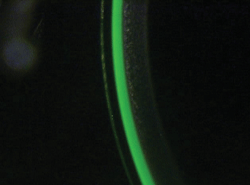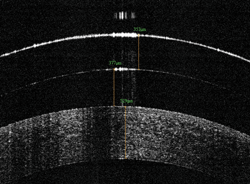Custom lenses are advantageous because they offer a larger parameter profile than standard lenses, encompassing a variety of optical zone sizes, add powers, high sphere and cylinder powers and diameters for patients with larger or smaller corneal than is normal. It’s an exciting time in the specialty contact lens world, as the materials and customizability of specialty lenses only continue to improve as the industry advances forward.
Cylinder Options
One of the most difficult obstacles you will face when fitting presbyopic patients—aside from the substantial matter of achieving adequate near vision correction—is the additional presence of astigmatism. As visually symptomatic astigmatism is an inevitability in very many patients, we are tasked with overcoming the triple threat: looking for lens options that correct not only the patient’s sphere and add power, but cylinder as well. Fitting difficulties also may arise with both the availability and design of lenses.

| |
| Slit-lamp and OCT Images showing proper corneal clearance for a scleral lens fit. The contact lens must clear the centra. cornea sufficiently to take into account eventual lens settling during the day.
| |

|
Currently, only CooperVision sells a stock multifocal toric soft lens in the US: the Proclear Multifocal Toric. This lens is available in two base curves and one diameter, with power ranging from +20.00 to -20.00, cylinder power up to -5.75 and add powers ranging from +1.00 to +4.00 in the manufacturer’s D and N designs. Otherwise, no other mass-produced soft lens design options exist from the leading manufacturers for presbyopic/cylindrical correction.
Instead, a host of custom lens designs—ranging from soft, hybrid, GP and scleral modalities—are available to correct both cylinder and presbyopia simultaneously. Aspects of normal GP lenses will not be discussed in this article, aside from the recognition that they are readily available in many modalities for both the spherical and cylindrical patient in a multitude of designs. Instead, the focus of this article will be on specialty soft, hybrid and scleral designs. Let’s look at the parameters that influence the lens design and fitting process for these challenging, but rewarding, patients.
Corneal Diameter
The latest custom soft lenses stand apart from available off-the-rack lens options in their increased prism and thickness profiles, base curve and diameter availabilities.
While the average corneal diameter measures 11.8mm, researchers found that approximately 10% of patients fall outside of the bell curve and are likely not best served by the standard 14.0-14.5mm lens diameter options.1 Patients who have much smaller or larger corneal diameters can wear a lens customized specifically to fit their cornea. This helps to guarantee that the lens is stable, which is critical if the patient has any cylinder present.
Determining a patient’s corneal diameter also helps to ensure that the lens is properly centered on the eye, which is crucial when fitting multifocal optics. Although corneal diameter is most critical for patients wearing soft lenses, it is also important for patients with hybrid and scleral lens modalities, as it affects the sagittal depth of these lenses. Large-diameter lenses do help to reduce the influence of corneal diameter on the fitting process, however.
To specify corneal diameter for a patient’s custom soft lens order, it is necessary to measure the patient’s horizontal visible iris diameter (HVID). Some slit lamps come equipped with ocular reticules for on-sight measurements, but a standard PD ruler in close proximity to the eye behind the slit lamp can be used to measure limbus-to-limbus. Another potential method is to use calipers from the topographer to measure white-to-white. If all else fails, you can estimate using a contact lens of known size, manually centering it with a known diameter soft lens, and then estimate the amount of overlap nasally and temporally.
The Power is in the Add
Custom multifocal lenses have the ability to not only specify add powers to the 0.1D, but also in powers outside of the add ranges typically offered by off-the-rack options. Emerging presbyopes who spend a considerable amount of time doing near work may benefit from the availability of lenses with +0.25D to +0.75D add powers. On the other end of the spectrum, patients who have advanced presbyopia or shorter working distances may benefit from add powers over +3.00D.
Zone Sizes
For patients with very large or very small pupils, or dynamic pupil changes, the ability to alter the asphericity or zone size may allow these patients, who typically struggle in traditional multifocal lenses, to achieve visual clarity and stability in custom lens designs. Standard multifocal lens designs in the center near or center distance modality typically have a 2mm center zone size, which may not be a viable option for patients with larger pupils. For patients with small, pinhole-like pupils, a slightly smaller zone size may make the transition between the near and distance portions of the lenses an easier process.
While most people work in normal room illumination conditions, patients who don’t (e.g., bartenders and waiters) may experience a mismatch between their pupil size and the zone size. To compensate for this, measure the patient’s pupil size in three separate illuminations: bright light, dim illumination (using the cobalt blue filter on either the slit lamp’s dimmest setting or a topographer) and normal room illumination. Ask the patient what lighting situation they’re in most frequently, and then select the size of the center zone accordingly. For example, a patient with a larger pupil than average during the day may exhibit increased visual problems due to their pupil size increasing when doing night driving or activities.
Currently, only two zone sizes are available in hybrid multifocals, but these can be customized in nearly any size for scleral designs and custom soft lenses. One such design from Valley Contax takes into account the patient’s dominant eye. The near zone in the dominant eye is made slightly smaller than the non-dominant eye and then, depending on the patient’s outcome, can further be customized with increased add power or altered zone diameters. It is important to remember that as the sagittal depth of a scleral lens changes, the zone size will be affected as it moves either further away from or closer to the patient’s pupil.
Alternative Materials
Many of your custom lens needs will be best served with the availability of the latest latheable silicone hydrogel materials, which offer higher Dks than previous incarnations, in conjunction with a lowered risk of hypoxia and peripheral neovascularization. For presbyopes with irregularly shaped anterior surfaces, such as those with keratoconus, high cylinder powers and irregular astigmatism, scleral or hybrid multifocal alternatives offer even more options to increase vision stability.
Hybrid multifocals offer the best of the hard and soft lens worlds: optimum clarity through gas-permeable optics combined with the comfort of soft lenses in the lens periphery. Similarly, scleral lenses can provide wearers increased comfort because the weight of the lens is distributed over the sclera, which contributes to less lid movement and lens-lid interaction.
In fitting scleral lenses, it’s critical to clear the entire central cornea with enough extra vault to compensate for the natural settling effects on the lens over the day. According to a 2012 study conducted by Caroline and Andre, the average scleral lens settles 127µm, so order the sagittal height 300 to 400 microns steeper to compensate for this effect and increase patient wear time.2 Keratoconic corneas on average need an additional 300 microns of clearance.
The Final Order
As with off-the-rack stock lens brands, no two custom lens labs are alike. Remember to work closely with your lab of choice regarding custom lens fitting, as their design features can alter the fit significantly from one lens to another. The devil truly is in the details when trying to achieve patient satisfaction in custom lens fits for presbyopes, particularly those with significant astigmatism.
While fit is important with any contact lens offering, centration of the multifocal lens is absolutely crucial, and the ability to tailor the lens based on each patient’s specific needs helps to guarantee success. By specifying your patient’s unique power, axis, corneal diameter, zone size, base curve and add power, you create not only a customized lens, but also an expanded practice scope and dedicated patient following.
Special thanks to Dr. Matthew Lampa and the Pacific University College of Optometry contact lens faculty.
Dr. Kading has been a consultant/advisor to and has received research/education grants from Optometric Insights, Alcon Laboratories, Allergan, Art Optical, Bausch + Lomb, Contamac, CooperVision, Visionary Optics, Nicox, Paragon, TruForm Optics, SynergEyes, RPS Detectors, Unilens, Valeant, Valley Contax and Vistakon.
Dr. Brujic has received honoraria from Alcon Laboratories Inc., Aton Pharma (Valeant), B+L, Odyssey, Rapid Pathogen Screening, TelScreen, Transitions, Vistakon and VMax Vision.
1. Caroline PJ, André MP. Determining Overall Sagittal Height of the Cornea. Contact Lens Spectrum, July 2002.
2. Caroline PJ, André MP. Scleral Lens Settling. Contact Lens Spectrum, May 2012.


